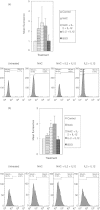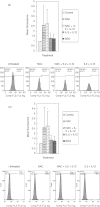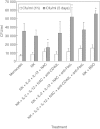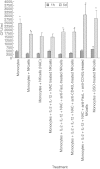Control of Mycobacterium tuberculosis growth by activated natural killer cells
- PMID: 22385249
- PMCID: PMC3390505
- DOI: 10.1111/j.1365-2249.2011.04552.x
Control of Mycobacterium tuberculosis growth by activated natural killer cells
Abstract
We characterized the underlying mechanisms by which glutathione (GSH)-enhanced natural killer (NK) cells inhibit the growth of Mycobacterium tuberculosis (M. tb) inside human monocytes. We observed that in healthy individuals, treatment of NK cells with N-acetyl cysteine (NAC), a GSH prodrug in conjunction with cytokines such as interleukin (IL)-2 + IL-12, resulted in enhanced expression of NK cytotoxic ligands (FasL and CD40L) with concomitant stasis in the intracellular growth of M. tb. Neutralization of FasL and CD40L in IL-2 + IL-12 + NAC-treated NK cells resulted in abrogation in the growth inhibition of M. tb inside monocytes. Importantly, we observed that the levels of GSH are decreased significantly in NK cells derived from individuals with HIV infection compared to healthy subjects, and this decrease correlated with a several-fold increase in the growth of M. tb inside monocytes. This study describes a novel innate defence mechanism adopted by NK cells to control M. tb infection.
© 2011 The Authors. Clinical and Experimental Immunology © 2011 British Society for Immunology.
Figures








Similar articles
-
Natural killer cells, glutathione, cytokines, and innate immunity against Mycobacterium tuberculosis.J Interferon Cytokine Res. 2008 Mar;28(3):153-65. doi: 10.1089/jir.2007.0095. J Interferon Cytokine Res. 2008. PMID: 18338948
-
NK cells regulate CD8+ T cell effector function in response to an intracellular pathogen.J Immunol. 2004 Jan 1;172(1):130-7. doi: 10.4049/jimmunol.172.1.130. J Immunol. 2004. PMID: 14688318
-
Natural killer cell-mediated cytokine response among HIV-positive south Indians with pulmonary tuberculosis.J Interferon Cytokine Res. 2010 Jan;30(1):33-42. doi: 10.1089/jir.2009.0018. J Interferon Cytokine Res. 2010. PMID: 20028198
-
Mechanisms of Control of Mycobacterium tuberculosis by NK Cells: Role of Glutathione.Front Immunol. 2015 Oct 5;6:508. doi: 10.3389/fimmu.2015.00508. eCollection 2015. Front Immunol. 2015. PMID: 26500648 Free PMC article. Review.
-
Glutathione and infection.Biochim Biophys Acta. 2013 May;1830(5):3329-49. doi: 10.1016/j.bbagen.2012.10.012. Epub 2012 Oct 23. Biochim Biophys Acta. 2013. PMID: 23089304 Review.
Cited by
-
Variants in the N-acetyltranferase 2 gene, acetylator phenotypes and their association with tuberculosis: Findings in Peruvian patients.J Clin Tuberc Other Mycobact Dis. 2024 Oct 16;37:100485. doi: 10.1016/j.jctube.2024.100485. eCollection 2024 Dec. J Clin Tuberc Other Mycobact Dis. 2024. PMID: 39502413 Free PMC article.
-
Characterizing the Effects of Glutathione as an Immunoadjuvant in the Treatment of Tuberculosis.Antimicrob Agents Chemother. 2018 Oct 24;62(11):e01132-18. doi: 10.1128/AAC.01132-18. Print 2018 Nov. Antimicrob Agents Chemother. 2018. PMID: 30126957 Free PMC article.
-
Innate immunity in tuberculosis: host defense vs pathogen evasion.Cell Mol Immunol. 2017 Dec;14(12):963-975. doi: 10.1038/cmi.2017.88. Epub 2017 Sep 11. Cell Mol Immunol. 2017. PMID: 28890547 Free PMC article. Review.
-
Pharmacogenomic heterogeneity of N-acetyltransferase 2: a comprehensive analysis of real world data in Indian tuberculosis patients and from literature and database review.Ann Med. 2025 Dec;57(1):2478316. doi: 10.1080/07853890.2025.2478316. Epub 2025 Mar 26. Ann Med. 2025. PMID: 40138446 Free PMC article.
-
BCG-induced protection against Mycobacterium tuberculosis infection: Evidence, mechanisms, and implications for next-generation vaccines.Immunol Rev. 2021 May;301(1):122-144. doi: 10.1111/imr.12965. Epub 2021 Mar 12. Immunol Rev. 2021. PMID: 33709421 Free PMC article. Review.
References
-
- Chiang CY, Centis R, Migliori GB. Drug-resistant tuberculosis: past, present, future. Respirology. 2010;15:413–32. - PubMed
-
- Deneke SM, Fanburg BL. Regulation of cellular glutathione. Am J Physiol. 1989;257(4 (Pt 1)):L163–73. - PubMed
-
- Griffith OW. Biologic and pharmacologic regulation of mammalian glutathione synthesis. Free Radic Biol Med. 1999;27:922–35. - PubMed
-
- Havlir DV, Getahun H, Sanne I, Nunn P. Opportunities and challenges for HIV care in overlapping HIV and TB epidemics. JAMA. 2008;300:423–30. - PubMed
Publication types
MeSH terms
Substances
LinkOut - more resources
Full Text Sources

